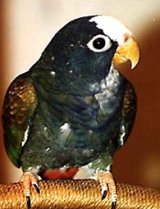
Once ingested, lead is degraded by acid in the stomach and absorbed in the bloodstream.
Lead toxicity may be acute or chronic. Chronic toxicity is the most common.
Lead affects all the major organs, including the gastrointestinal epithelium, liver, red blood cells, bone marrow and nervous system.
Clinical signs depend upon the amount of lead ingested, the surface area of the lead particles and the amount of time the lead is in the gastrointestinal tract. Neurologic, gastrointestinal and hematologic signs are usually present. Neurologic signs include tremors, weakness, wing droop, leg paesis, seizures and blindness. Gastrointestinal signs include loss of appetite, regurgitation, crop stasis, weight loss and green-black diarrhea. Increased thirst and increased urine production may also occur. Anemia is often present. Amazons may have blood in their urine.
Birds that ingest large amounts of lead over a short period of time may die suddenly, without any signs of toxicity.
Diagnosis of lead toxicity can be very difficult. Radiographs may demonstrate metallic densities in the gastrointestinal tract. The absence of metallic densities, however, doesn’t rule out lead toxicity, since it can occur from non-radiodense materials such as paint chips or gas fumes. In addition, not all metal densities are lead.
In addition, a bird may develop signs of toxicity following the mobilization of lead that has been stored in the bones months after ingestion.
Blood lead levels may be run by a laboratory. Although this is very important, it can take several days for the test results to be back.
If there is a strong suspicion that a bird has lead toxicity, treatment is usually started after blood has been taken.
Chelation therapy with CaEDTA or D. penicillamine is begun. The chelation agent removes the lead that is circulating in the blood.
Emollient cathartics such as psyllium, peanut oil or peanut butter can be given to aid the passage of small particles of lead out of the digestive tract. Oral magnesium sulfate precipitates lead, preventing further absorption.
Activated charcoal can be given orally to bind the small lead particles, making them unavailable for absorption.
If the metal particles are large, they may be removed by a fiberoptic endoscope.
The bird is monitored by followup radiographs if lead was demonstrated on the initial films taken as well as with blood lead levels following a period of chelation treatment.
Many birds will recover if they are diagnosed early and treated appropriately. They will show a dramatic response to treatment within 24 to 48 hours of beginning treatment.

